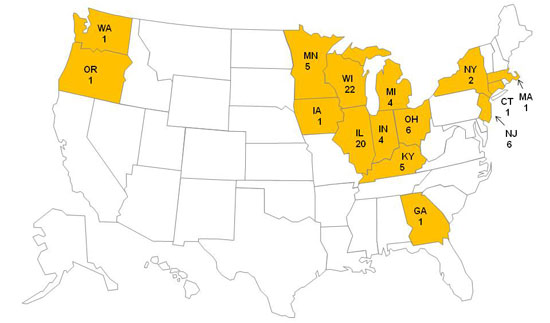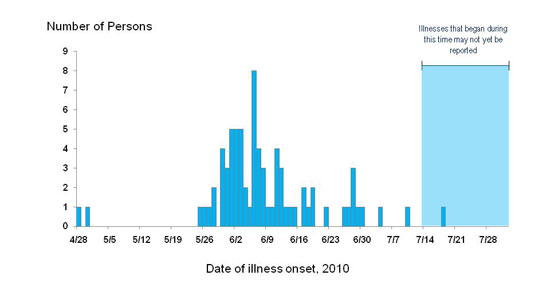2010 Salmonella Outbreaks Associated with Restaurant Chain A
NOTICE: This outbreak is over. The information on this page has been archived for historical purposes only and will not be updated.
Posted August 4, 2010
Outbreak Summary
CDC is collaborating with public health officials in multiple states, the U.S. Food and Drug Administration (FDA), and the U.S. Department of Agriculture’s Food Safety and Inspection Service (USDA/FSIS) to investigate two multistate outbreaks of Salmonella infections, each involving a different Salmonella serotype: Hartford and Baildon. Both of these Salmonella serotypes are rare, and ill persons in both outbreaks have a similar age and geographic distribution. Investigators are using DNA analysis of Salmonella bacteria obtained through diagnostic testing to identify cases of illness that may be part of these outbreaks.
Epidemiologic studies comparing foods eaten by ill and well persons were conducted for both of these multistate outbreaks. In each study, analysis indicates that eating at a Mexican-style fast food restaurant chain, Restaurant Chain A, is associated with some illnesses. Among persons eating at Restaurant Chain A, no specific food item or ingredient was found to be associated with illness for either outbreak. The numbers of new cases for the Salmonella Hartford outbreak have declined substantially since a peak in early June 2010. The numbers of new cases for the Salmonella Baildon outbreak have declined substantially since a peak in late June 2010. The number of new cases of illness associated with these outbreak strains appears to have returned to baseline, indicating the outbreaks are not ongoing.
In both outbreaks, the FDA worked with CDC and state partners to conduct a traceback investigation. The tracebacks focused on produce that ill individuals reported eating and that had been implicated in previous outbreaks of salmonellosis. The extensive traceback effort was initiated to determine if a common source or supplier could be identified to help focus the epidemiologic investigations. No common food source was identified in either traceback. The FDA also sampled and tested produce items and did not find either outbreak strain. As with previous outbreaks in which contaminated produce may be the factor, produce tracebacks present substantial challenges because of the short shelf life of the product and the industry’s comingling of product from multiple sources.
A widely distributed contaminated food product might cause illnesses in a specific region and across the United States. Although neither outbreak appears to be ongoing, indicating no continued risk of infection from this source, CDC and its public health partners are continuing their efforts to identify the specific contaminated product or products that caused illness and will update the public on the progress of this investigation as information becomes available.
These outbreaks can be visually described with a chart showing the number of people who became ill each day. This chart is called an epidemic curve or epi curve. Some Salmonella illnesses associated with these outbreaks that occurred after July 19, 2010, might not yet be reported due to the time it takes between when a person becomes ill and when the illness is reported. This takes an average of 2 to 3 weeks. For more details, please see the Timeline for Reporting Cases of Salmonella Infection.
Salmonella Hartford Outbreak Investigation
As of August 1, 2010, a total of 75 individuals infected with a matching strain of Salmonella Hartford have been reported from 15 states since April 1, 2010. The number of ill people identified in each state with this strain is as follows: CO (1), FL (1), GA (1), IL (5), IN (11), KY (23), MA (2), MI (3), MT (1), NC (1), NH (1), NY (1), OH (19), PA (1), and WI (4). Among those for whom information is available about when symptoms started, illnesses began between April 30, 2010 and July 18, 2010. Case-patients range in age from <1 to 80 years old, and the median age is 39 years. Fifty-seven percent of patients are female. Among the 47 patients with available hospitalization information, 15 (32 %) were hospitalized. No deaths have been reported.
During June 30 to July 9, 2010, CDC and public health officials in multiple states conducted an epidemiologic study by comparing foods eaten by 43 ill and 97 well persons. Analysis of this study indicates that eating at Mexican-style fast food Restaurant Chain A was associated with illness. Ill persons (60 %) were significantly more likely than well persons (21%) to report eating at Restaurant Chain A in the week before illness. Among persons eating at Restaurant Chain A, no specific food item or ingredient was found to be associated with illness based on an epidemiologic study comparing foods eaten by 24 ill and 28 well persons. Ill persons reported eating at 13 different locations of Restaurant Chain A in the week before becoming ill. A total of 4 locations were identified where more than one ill person reported eating in the week before becoming ill.
Salmonella Baildon Outbreak Investigation
As of August 1, 2010, a total of 80 individuals infected with a matching strain of Salmonella Baildon have been reported from 15 states since May 1, 2010. The number of ill people identified in each state with this strain is as follows: CT (1), GA (1), IA (1), IL (20), IN (4), KY (5), MA (1), MI (4), MN (5), NJ (6), NY (2), OH (6), OR (1), WA (1) and WI (22). Among those for whom information is available about when symptoms started, illnesses began between May 11, 2010 and July 19, 2010. Case-patients range in age from 1 to 82 years old, and the median age is 47 years. Seventy-four percent of patients are female. Among the 68 patients with available hospitalization information, 27 (40 %) were hospitalized. No deaths have been reported.
During July 18 to 30, 2010, CDC and public health officials in multiple states conducted an epidemiologic study by comparing foods eaten by 52 ill and 125 well persons. Analysis of this study also indicates that eating at Mexican-style fast food Restaurant Chain A was associated with illness. Ill persons (65%) were significantly more likely than well persons (15%) to report eating a restaurant chain A in the week before illness. Among persons eating at Restaurant Chain A, no specific food item or ingredient was found to be associated with illness based on an epidemiologic study comparing foods eaten by 33 ill and 96 well persons. Ill persons reported eating at 22 different locations of Restaurant Chain A in the week before becoming ill. Three locations were identified where more than one ill person reported eating in the week before becoming ill. No common locations of Restaurant Chain A were reported by ill persons in both the Salmonella Baildon and Salmonella Hartford outbreaks.
Unique Features of These Outbreak Investigations
- There are over 2,500 serotypes of Salmonella. Hartford and Baildon are very rare serotypes of Salmonella.
- CDC used its Emergency Operation Center facilities and mobilized employee and student volunteers to conduct two large case-control studies within several weeks of each other. These studies involve calling thousands of U.S. residents to screen them for eligibility into the study and, once determined eligible, interviewing them about the foods they had eaten during a certain period. These studies are not possible unless people who are called agree to be interviewed. CDC thanks every person who participated in these telephone interviews.
- The Mexican-style fast food Restaurant Chain A, as well as their food suppliers and distributors, were very cooperative in providing extensive information to public health officials as various leads were explored.
Clinical Features/Signs and Symptoms of Salmonella-related Illness
Most people infected with Salmonella develop diarrhea, fever, and abdominal cramps 12–72 hours after infection. Infection is usually diagnosed by culture of a stool sample. The illness usually lasts 4 to 7 days. Although most people recover without treatment, severe infections can occur. Infants, elderly people, and those with weakened immune systems are more likely than others to develop severe illness. When severe infection occurs, Salmonella may spread from the intestines to the bloodstream and then to other body sites and can cause death unless the person is treated promptly with antibiotics. Read more on Salmonella.
Advice to Consumers
- At this time, consumers are not being advised to avoid eating any specific foods or to avoid eating at any specific restaurants.
- If a food source is identified for these outbreaks and if there is evidence of continued risk of infection, public health officials will advise the public and take the necessary steps to avoid risk of additional illnesses.
General Information
Final Case Count Map
Persons infected with the outbreak strain of Salmonella Hartford, by state, as of August 1, 2010 (n=75)

As of August 1, 2010, a total of 75 individuals infected with a matching strain of Salmonella Hartford have been reported from 15 states since April 1, 2010. The number of ill people identified in each state with this strain is as follows: CO (1), FL (1), GA (1), IL (5), IN (11), KY (23), MA (2), MI (3), MT (1), NC (1), NH (1), NY (1), OH (19), PA (1), and WI (4).
Persons infected with the outbreak strain of Salmonella Baildon, by state, as of August 1, 2010 (n=80)

As of August 1, 2010, a total of 80 individuals infected with a matching strain of Salmonella Baildon have been reported from 15 states since May 1, 2010. The number of ill people identified in each state with this strain is as follows: CT (1), GA (1), IA (1), IL (20), IN (4), KY (5), MA (1), MI (4), MN (5), NJ (6), NY (2), OH (6), OR (1), WA (1) and WI (22).
Final Epi Curve
This outbreak can be visually described with a chart showing the number of persons who became ill each day. This chart is called an epi curve. Please see the Timeline for Reporting Cases of Salmonella Infection for more details on the reporting process.
Persons infected with the outbreak strain of Salmonella Hartford, by date of illness onset*

*n=75 for whom information was reported as of August 1, 2010. Some illness onset dates have been estimated from other reported information.
Persons infected with the outbreak strain of Salmonella Baildon, by date of illness onset*

*n=80 for whom information was reported as of August 1, 2010. Date of isolation by week.